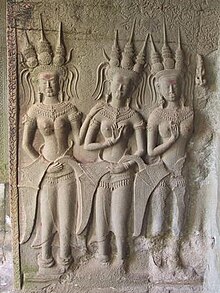Temple dance
Religious performance held in Hindu temples

Temple dance denotes a religious performance held in the temples, such as sadir, prescribed by Agamas (scriptures that codified temple rituals, etc.).[1][2] Traces of these ancient temple dances of India are seen in Bharatanatyam and Odissi.[3]
The sacred Hindu temple dance used to be performed by devadasis and Mahari Dance, who were supposed to manifest in the material body the heavenly dance of apsaras.[1]
References
- ^ a b Younger, Paul; Younger, Professor of Religious Studies Paul (1995). The Home of Dancing Śivan̲: The Traditions of the Hindu Temple in Citamparam. Oxford University Press. ISBN 978-0-19-509532-6.
- ^ Subramuniyaswami, Satguru Sivaya (2003). Dancing with Siva: Hinduism's Contemporary Catechism. Himalayan Academy Publications. ISBN 978-0-945497-89-9.
- ^ Narayan, Shovana (30 December 2011). The Sterling Book of INDIAN CLASSICAL DANCE. Sterling Publishers Pvt. Ltd. ISBN 978-81-207-9078-0.
External links
 Media related to Hindu temple dance at Wikimedia Commons
Media related to Hindu temple dance at Wikimedia Commons
- v
- t
- e
Dance in India
- Perini Sivatandavam
- Margamkali
- Koothu
- Parai Attam
- Theyyam
- Veeranatyam
| Recognised | |
|---|---|
| Others |
- Alkap
- Baagh Naach
- Bagurumba
- Bardo Chham
- Bardwi Sikhla
- Bedara Vesha
- Bhangra
- Bihu
- Bommalattam
- Chakyar koothu
- Chang
- Chang Lo
- Cheraw
- Chheih Lam
- Chholiya
- Corridinho
- Dalkhai
- Dandiya Raas
- Dhalo
- Dhunachi
- Dollu Kunitha
- Domkach
- Domni
- Duffmuttu
- Dumhal
- Fugdi
- Garadi
- Garba
- Giddha
- Ghoomar
- Ghumura
- Gombhira
- Grida
- Hojagiri
- Hulivesha
- Jhijhiya
- Jhumar
- Jhumair
- Kachhi Ghodi
- Kalbelia
- Karakattam
- Karma
- Keisabadi
- Khual Lam
- Kikkli
- Kolattam
- Kummi
- Lavani
- Lahasua
- Lezim
- Maach
- Malwai Giddha
- Mardana Jhumair
- Matki
- Mayilattam
- Mussoll
- Nacnī
- Nati
- Oppana
- Oyilattam
- Paampattam
- Padayani
- Pavri Nach
- Phulpati
- Poikkal Kuthiraiattam
- Puli Kali
- Puliyattam
- Rasiya
- Raut Nacha
- Saang
- Singhi Chham
- Sword dance
- Tertali
- Thirayattam
- Thitambu Nritham
- Tippani
- Veeragase
- Yakshagana
- Natya Shastra
- Abhinavabharati
- Mudras
 | This article about Indian dance is a stub. You can help Wikipedia by expanding it. |
- v
- t
- e
 | This Hinduism-related article is a stub. You can help Wikipedia by expanding it. |
- v
- t
- e
 | This Indian theatre-related article is a stub. You can help Wikipedia by expanding it. |
- v
- t
- e











